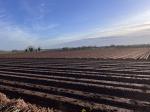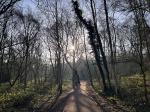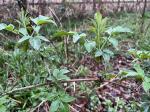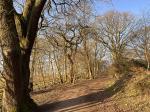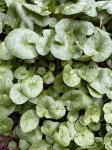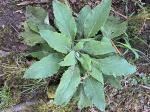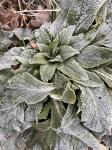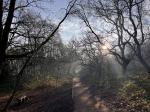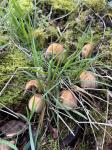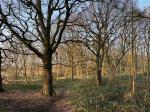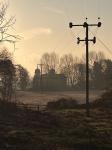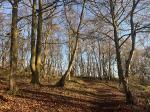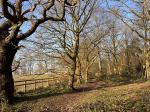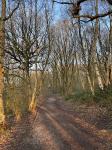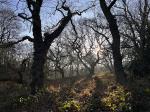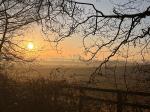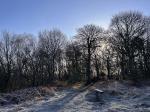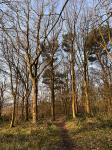Brayton Barff Through the Seasons.
Set in the Vale of York, South West of the market town of Selby and between the villages of Thorpe Willoughby and Brayton, lies Brayton Barff, a sandstone Hill approximately one hundred and fifty feet in height which was formed by glacial movement during the last Ice Age. It is a significant landmark in an otherwise flat landscape.
Today the site is primarily owned by Yorkshire Water with Selby District Council owning a small patch of the land adjacent to the A63 Selby bypass. A large underground reservoir occupies the centre of the site which delivers water to around 4.7 million customers throughout Yorkshire.
Within the Barff woodland over 40% of the trees are Sessile Oak which are generally found in semi natural woodlands in the north of the country. These trees are so called because its acorns are not held on stalks, like those of the English Oak (Pedunculate), but attached directly to the outer twigs. There are also several English Oak trees as well as some cross-hybrid oaks. These trees are known to support many species of flora and fauna, invertebrates, mosses, lichen and fungi.
During the Victorian times it is thought that the shipbuilders on the east coast would come over to the Barff for selected cuts of timber to build their sea going vessels.
The Barff also has a variety of other trees including Silver Birch, Beech, Sycamore, Holly, Rowan, Scots Pine, Alder, Hawthorne and European Larch. There are also several Yew, Willow, Hazel, Horse Chestnut and Wych Elm. As with similar woodlands there are a variety of bushes, including Honeysuckle, Elderberry, Gorse, Broom and Buddleia.
The history of Brayton Barff is quite vague, apparently during 1803 a beacon was lit on the Barff when the country was threatened with an invasion by Napoleon. In May 1935, to celebrate King George V's Silver Jubilee, a Bonfire was lit on the Barff as part of the celebrations.
Early issues of Ordnance Survey Maps dated 1903 clearly show a rifle range on the Barff, extending out to Mill Lane. During the 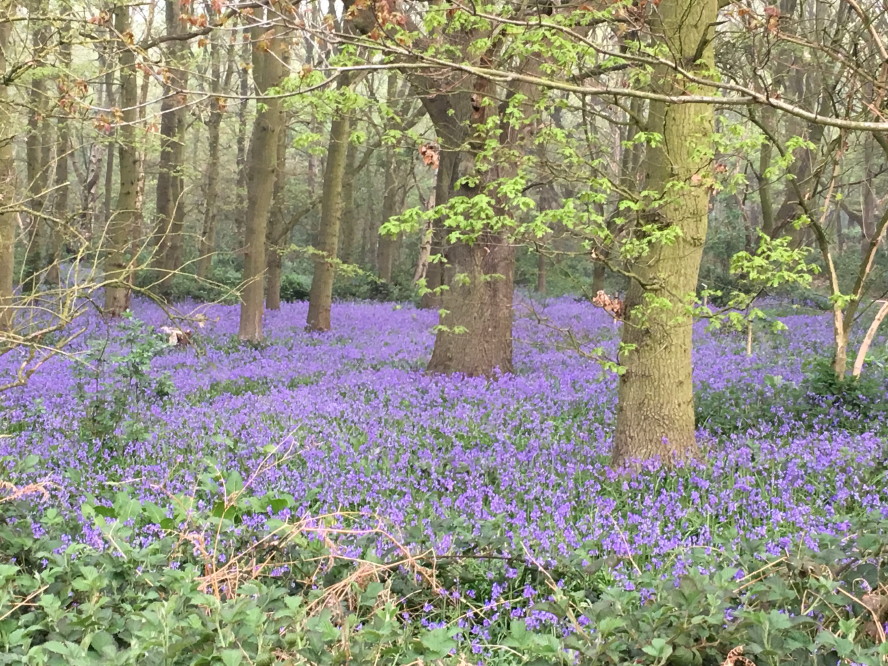
Between 2001 – 2004 the A63 Selby bypass, 10km twin lane single carriageway was constructed which severed the South West corner of the Barff, adjacent to Selby Golf Course and resulted in a slight redesign of several holes on the golf course. Wooden fencing was erected as a result of this new road running alongside of the Barff and a footbridge constructed over the ‘new road’ following the line of the Bridal way which extends from Mill Lane. Around 2005/2006 a definite 2metre wide limestone aggregate footpath was laid forming a circular path around the outer edges of the woodland. This footpath is approximately 1.2 miles in length and takes about 30 minutes to circumnavigate at a leisurely pace.
In 2012 the Barff was declared an Ancient Oak Woodland and as such throughout 2012 and 2013 significant work had been carried out by the relevant agencies to cut and remove large swathes of non-native trees, creating at that time huge scars on the landscape. Some three years later the planting of the native trees have become well established and are flourishing. Ongoing maintenance work on the footpath around the bottom of the Barff was completed during the Summer of 2016.
A second phase of woodland maintenance commenced during the Autumn of 2019 with the removal of many old and diseased trees and the cutting back of the Gorse and Broom bushes, especially adjacent to the ‘bypass trail’, this work continued through till March 2020 with re planting continuing into April 2020.
Brayton Barff is a popular site for walkers and bird watchers alike and a path circling the outer perimeter of the Barff makes a pleasant thirty minute walk, giving views looking over towards Selby and the village of Brayton as well as the power stations of Drax and Eggborough..jpg)
For the early risers it is a great place to see some stunning sunrises over the villages of Brayton looking towards Drax Power Station, the same with the Sunsets looking over towards Eggborough and Monk Fryston.
The Barff changes with the Seasons and every visit can reveal something new, the woodland is a haven for wildlife. Records show that since 1982 one hundred and twelve species of bird have been seen in the woodland and at least 40 of those have bred here, including Tawny Owl, Buzzard, Green Woodpecker, Spotted Flycatcher, Goldcrest and Nuthatch to name just a few. On average over 70 species of bird are recorded each year. Further details of the bird life on the Barff can be found on the Brayton Barff Group Facebook page, especially the posts from Derek Cooper. Today ‘The Friends of Brayton Barff group’ led by Derek and a small team of volunteers help keep and maintain the cleanliness of the site as well as recording the wildlife and bird sightings.
The Barff is also home to fifteen different species of mammals, including Muntjac Deer, Pipistrelle Bat, Fox, and Field Vole.
Over eighty species of plant and wildflowers have been recorded, included Bee Orchid, Northern Marsh Orchid, Wood Anemone, Marsh Ragwort, Bluebell, White Bluebell, Bittersweet and Purple and White Foxgloves. Over twenty species of Butterfly have been recorded, including Marbled White, Brown Angus, Speckled Wood, Comma and Brimstone.
During the Autumnal months fungi thrives in this woodland environment, species including Fly Agaric, Beefsteak Tree Fungi, Chicken of the Wood, Sulphur Tufts, Stinkhorn, Ink cap, Puffballs and Hoof Bracket are just some of the many varieties that can be found here.
Click on the galleries shown below to expand the albums.
March 2025
The month got off to a cold, dry and bright start. The Greater Spotted Woodpecker, Song Thrush, and Mistle Thrush have been very vocal throughout the week, along with Robin, Wren, Great and Blue Tits.
One of the first shrubs to flower on the Barff after the Gorse bushes (which started flowering in January,) are the Blackthorn bushes, and can be seen along the bypass trail, their small white flowers have started to appear in clusters on short stalks before the leaves and adds some more colour to the woodland. Its flowers are a welcome source of nectar and pollen for the emerging insects and is a rich source of nourishment especially for the bees.
The second week was much dryer with long spells of sunshine, we had several mornings of frost but that soon evaporated once the sun rose. Song Thrush, Mistle Thrush and Chiffchaff have been very vocal all week and the Greater Spotted Woodpecker has continued drumming close to the car park area and another by the service road entrance. It has been good to hear a passing Green Woodpecker yaffling away. A couple of early morning frosts has kept the morning temperature down but despite the cold start it has remained a dry week.
The early morning frosts continued throughout the third week of the month, Song Thrush and Chiffchaff being extremely vocal, accompanied by the Robins, Wren, Great and Blue Tit and occasionally the Mistle Thrush. Several clumps of Daffodils on the Barff summit are flowering nicely at this time. I tried to walk around the top perimeter fence this week from the top corner of Tap Hill but within fifty feet the path was completely blocked by the unmanaged Brambles. We have seen some very atmospheric and misty sunrises this week, the sunrising around 6,30am. Sightings of the first flowering Bluebell have been seen this week. The tiny flowering blue violets which have been flowering along the Bypass trail have all but died back this week. Dandelion and Lesser Celandine are starting to flower. The first day of astronomical Spring fell on the 20th which was a dry, bright, and sunny morning.
The final week of the month was much the same as the previous, a touch of frost one morning, the next 10c and very mild. March has been a dry month, with minimal rain fall, records show it has been the driest March since 1961! And afternoon temperatures rising to 15c. The daily sunshine and warmer afternoons has been sufficient for the Bluebells to start flowering with new flowers appearing daily.
It has been good to see the farmers ploughing and sowing potatoes in the fields alongside the woodland, the deep furrows razor sharp and straight, its looks as though they are getting caught up after last year’s disaster when a lot of crops could not be planted due to the heavy rain and wet ground conditions.
Wild flowers have suddenly started to shoot up, Lesser Celandine is beginning to flower, along with Dandelion. The Honeysuckle is growing apace around the tree trunks on the Barff summit, Wood Anemone and Wild Garlic can be seen along the edges of the perimeter footpath. Blackthorn blossom has been a picture, especially along the Bypass trail. Bramble continues to sprout up overnight, Cow Parsley is spreading alongside the perimeter footpath, and should come into flower towards the end of April. Huge swathes of Nettles seem to appear overnight and the Foxgloves which have been quite dormant over the winter are beginning to fill out and are starting to grow. Fallen Hazel Catkins have been littering the upper reaches of the service road.
Birdsong has been exceptional in March and always lifts the spirit when you arrive on the woodland, the chief chorists in March being the Song Thrush and Chiffchaff the latter accompanying us on our walks every day. Mistle Thrush occasionally joins in, and is always accompanied by the gentle cooing of the Wood Pigeons. Robin, Chaffinch and Wren, along with Great and Blue Tit always provide a harmonious tune. The Dunnock and Blackcap arrived into the woodland within a day or so of each other just a couple of days earlier than last year, both complement our existing chorists very nicely. Their numbers will increase significantly over the next month. It was good to see a small flock of sheep returning to one of the fields adjoining the Barff. Spring has certainly arrived.
|


